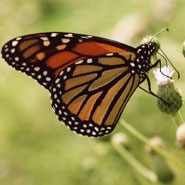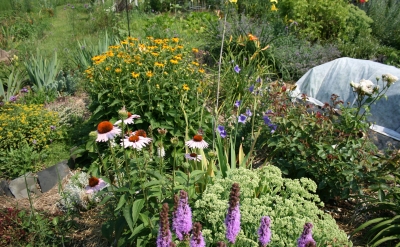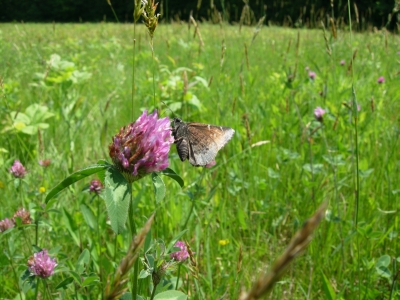Massachusetts Butterfly Club
Butterfly Conservation
Can You ID This Butterfly?

Options:
1. Mouse over the photo to see the species name.
2. Click the photo to see the
species web page.
3. Click here to see a new photo.
|
This page is comprised of three sections. Links to those sections:
Another resource is the Gagear Lab web page  WHAT INDIVIDUALS CAN DO TO PROMOTE BUTTERFLY CONSERVATION  MOWING GUIDELINES FOR FIELDS AND GRASSLANDS The best practice, which will benefit the most species of butterflies, is to mow such areas no more than once year, in the late fall. Keep the mower height at least 4 to 6 inches off the ground, since larvae will be over-wintering near the ground at the base of plants, and leave the cuttings in place to decompose over the winter. If possible, mow with a sickle bar to minimize damage to overwintering life forms. At each mowing, it is important to leave some unmowed areas, even small ones, as “insect refugia.” A good way to accomplish this is mowing on a rotational basis, cutting only one-half or one-third of an area each year. Mowing may not be appropriate for some land situations or for particular species of butterfly. Some native grasslands in Massachusetts, such as dry stands of Little Bluestem, sandplain grasslands near the coast, and native wet meadows, can often maintain themselves naturally, and should not be mowed at all. Areas like this provide habitat for uncommon species of butterflies and moths, and should be protected. Mowing can be done around edges if shrubs are encroaching, and individual shrubs can be spot-treated. Other than these special areas, most meadows in New England will need mowing to keep them open. Mowing in June, as is done in many fields managed for hay production, is very detrimental to butterflies, as well as other Lepidoptera and wildlife. Farming for hay production may keep fields open, but is not usually compatible with good management for butterflies. Mowing once in late fall, on the other hand, allows seeds of many important host and nectar plants, such as Queen Anne’s Lace, dock, turtlehead, Joe-Pye weed, milkweed, and asters, to mature and disperse, so that these beneficial plants spread. Mowing once every year or two is usually necessary to allow low-growing host plants, such as violets for Fritillaries, lance-leaved plantain for Baltimores, and grasses for satyrs and skippers, to grow rather than being shaded out. Not mowing will encourage shrubs such as blueberry, bearberry, spirea, viburnums, dogwoods and clethra, along with saplings of beneficial trees such as black cherry, poplar, spicebush, sassafras, willow, elm and juniper. These plants are hosts to another suite of butterflies and moths, such as Viceroys, Red-spotted Purples, Spicebush Swallowtail, and New England Buck Moth, which should also be encouraged. Shrublands are a declining habitat type, and very valuable in their own right, so landowners may want to manage some areas as shrublands, cutting them only every five to ten years. Shrub habitat should also be provided by maintaining “hedgerows” at the perimeter of fields and selectively removing invasives such as Buckthorn, Oriental Bittersweet, and multiflora rose. Whether one might want to plow and re-seed a piece of land depends on its land use history and what species of plants and butterflies are now present. If the land has never been disturbed or plowed--for example, it may have historically been used only for grazing, or woodcutting, or haying of native vegetation—plowing will be quite detrimental. Such disturbance destroys the pre-existing soil structure and its microorganisms, and creates the conditions in which some species, such as goldenrod, can become invasive. Native spring ephemeral wildflowers, which include woodland violets, lance-leaved violet, and bird-foot violet, the sole hosts for our Fritillary butterflies, are destroyed by plowing and are not able to recolonize old fields for 30 to 50 years, in part because their seeds are ant-dispersed and do not travel very far. If, on the other hand, the soil has already been disturbed, for construction or for agriculture, and the area is not now good butterfly habitat, then plowing, liming and replanting with a native meadow mix would be a good thing to do. (Revised April 6, 2008)  RESOURCES FOR LAND MANAGERS Butterfly conservation in our region and elsewhere Cech, R. and G. Tudor. 2005. - Butterflies of the East Coast: An Observer’s Guide, Princeton University Press. Atticus W. Murphy and Elizabeth E. Crone (August 2021)
https://butterfly-conservation.org/ [Great Britain] https://www.xerces.org/ [all insects] Frosted Elfin and other rare and listed species Albanese, Gene. 2007. Recent Research on Frosted Elfin Habitat Requirements. (PDF) Nelson, M. 2004. A Daydream Journey: Searching for Rare Insects in New England. New England Wildflower Society, Conservation Notes. Vol. 8, No. 2, pp 28-31. Wagner, D.L., M. W. Nelson, and D. F. Schweitzer. 2003. Shrubland Lepidoptera of southern New England and southeastern New York: ecology, conservation, and management. Forest Ecology and Management, 185, 95-112. (PDF) Harris’ Checkerspot Gach, Martha. 2008. Growing Jewels – Managing for Harris’ Checkerspot and other Lepidoptera. Massachusetts Butterflies, No. 30, Spring. pp. 2-12. (PDF) Stichter, S. 2008. A Species to Watch: Harris’ Checkerspot. Massachusetts Butterflies, No. 30, Spring. pp. 13-19. (PDF) Williams. E.H. 2002. Harris’ Checkerspot: A Very Particular Butterfly. American Butterflies. Vol. 10, No. 2. Summer. pp. 18-25. Fritillaries Art, Henry. 2004. Ants: Wildflower Gardeners. New England Wild Flower Society, Conservation Notes, Vol 8, No. 2. pp. 12-13. McLachlan, Stephane M., and Dawn R. Bazely. 2001. Recovery Patterns of Understory Herbs and Their Use as Indicators of Deciduous Forest Regeneration. Conservation Biology, Vol . 15 No. 1. February. pp. 98-110. [Discusses the slow recovery patterns of violets after disturbance.]" Wagner, David L., Matthew S. Wallace, George H. Boettner, and Joseph S. Elkinton. 1997. "Status Update and Life History Studies on the Regal Fritillary (Lepidoptera: Nymphalidae)". pp 261-275 in Peter D.Vickery and Peter W. Dunwiddie, eds., Grasslands of Northeastern North America: Ecology and Conservation of Native and Agricultural Landscapes." Massachusetts Audubon Society. [Discusses the failure of the reintroduction project on Martha's Vineyard.] (PDF) (This copy is being made available with the permission of Mass Audubon.) Negative impacts of fire Black, Scott Hoffman. 2009 "Butterflies and Fire: Ashes or Phoenix?" News of the Lepidopterists' Society Vol 51, No. 4, Winter . Swengel, Ann. 2008. "Poweshiek Paradise Lost." American Butterflies Vol. 16, No. 4. Winter. pp. 16-32. Orwig, Tim, and D. Schlict. 1999. "The Last of the Iowa Skippers." American Butterflies Vol. 7, No. 1. Spring. pp. 4-12.
(Revised March 5, 2009) Photo credits: Sue Cloutier |